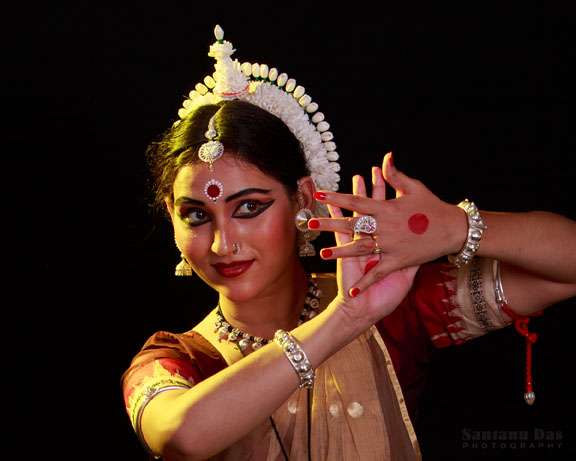The Odissi dance form, divine in origin and with a spiritual grandeur, has been influencing the Indian cultural scene since ages. It still exudes its own aura, mood and character, says acclaimed Bhubaneswar-based Odissi dancer Arupa Gayatri Panda who literally lives Odissi. Her supple and graceful movements and eloquent expressions show a mastery over the dance form. Besides having performed across India, she has also been to many other countries including the USA, Canada, and China to promote Odissi dance and Odia culture.
Arupa says, “I was barely three when I took to dancing. I have heard my parents say that I used to dance sometimes for two hours at a stretch. A few neighbours suggested to my father that he should enrol me in a dance class. My father asked an Odissi dancer Puspa Ranjan Mangraj, who used to visit our home to learn stenography, to teach me the classical dance form. That is how I began.”
She continues: “When I was in Class II, I honed my skill further under the tutelage of Sarita Mishra. However, after I joined the Odisha Dance Academy run by the late Padmashree Gangadhar Pradhan in 1999, I got many opportunities to showcase my dance prowess. Odissi exponents like Guru Madhusmita Mohanty and Aruna Mohanty guided me while Padmashree Guru GangadharPradhan supervised my learning at the Academy.”
Arupa says she owes a lot to the Odisha Dance Academy and the incredible dancers and teachers there who taught her to aim for the stars.
“Simply by being such exquisite dancers, they set a standard for me that I will always strive to reach. They are scholars who are redefining so many things in dance theory and choreography, and this has helped me ask many questions about my own work as a young dancer. I will always be grateful for everything I have learnt and continue to learn from them.”
Arupa has performed atmost major dance festivals of India, including the Ananya Festival, Khajuraho Dance Festival, Nrutyagram festival in Bangalore, and Konark festival. She is a Grade A artiste of Doordarshan and has performed a number of times on the channel. Apart from running an Odissi dance institution ‘Nrutya Rupa,’ she also works as an assistant professor at Sri Sri University.
What binds Arupa to Odissi? She says, “It’s my devotion for Lord Jagannath that connects me to Odissi. As you know, Odissi dance pays great importance to Lord Jagannath, who is considered the lord of the universe and is worshipped by the people of Odisha. The first archaeological evidence of this dance was seen in a cave engraving of a dancer near Udayagiri. This is believed to have been made during the reign of emperor Kharavela who enjoyed this dance form and played a great role in popularising it. These dancers were widely referred to as ‘maharis,’ in other words, temple dancers. While performing, I get completely involved in the dance and enter a different world where I communicate with Lord Jagannath. And this feeling gives me a sense of satisfaction.”
Remembering a memorable experience, she says, “I was performing ‘Madhurashtakam’ at a programme‘Kal Ke Kalakar’ in Mumbai. Ritha Devi, a luminous dance personality, an extraordinary scholar and a celebrated critic, was the chief guest. She liked my performance a lot and told me, ‘Your performance made me feel as if a ‘mahari’ is performing in front of Lord Jagannath.’ I was really overwhelmed by her words.”
Arupa shares another story to explain her bonding with the classical dance form. “Padmashree Aruna Mohanty once invited me to be a part of theprogramme ‘Amazing Odisha’ hosted by the Odisha Society of America. I was supposed to perform at many places over a period of one month. When I expressed my desire to accompany Aruna ma’am and perform in the US, my mother-in-law said no because my father-in-law was not well at that time. She asked me, ‘Do you think this tour is important for you?’ My answer was, yes, I have to go. I left for the US leaving everything to the Almighty.”
She adds: “I am lucky to have a supportive husband and in-laws. Had they not supported me,I would not have had a smooth journey towards success.”
Arupa says she truly got inspired to learn Odissi after hearing the story of the famous Odissi exponent, Sanjukta Panigrahi. “Dance, for Sanjukta, was life. It was not just an art form, not just a passion. It meant more to her. She belonged to an orthodox and conservative Brahmin family. She faced many challenges in her bid to prove her mettle as a danseuse. When I was in Class IX, I received the Sanjukta Panigrahi scholarship. It was the best day of my life and her story motivated me to continue to dance.”
Arupa, who is known for her expressions and stage presentation, says her forte is ‘abhinaya.’ “‘Abhinaya,’ derived from Bharata Muni’s Natyashastra is an integral part of all Indian classical dance styles. ‘Abhinaya’ does not mean only acting, miming or facial expressions. The term applies to all the related aspects of histrionics which contribute in conveying the poetic content of drama to the spectators,” states Arupa who has played the character of poet Jayadev’s wife Padmavati in the daily soap ‘Sri Jagganath ‘ aired on TV.
RASHMI REKHA DAS, OP
